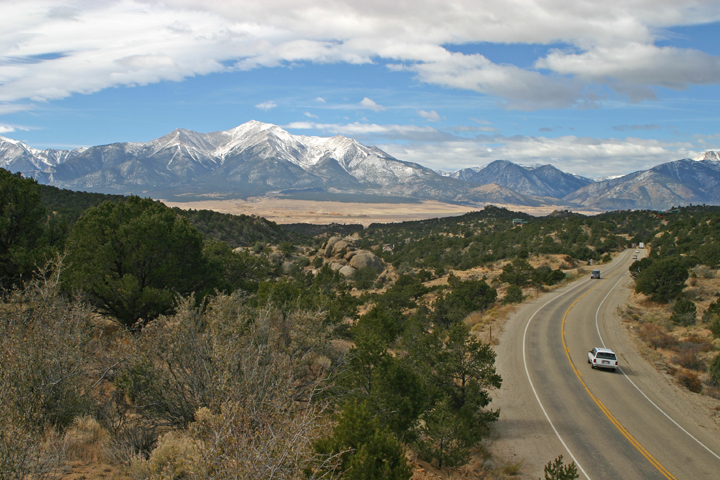by Alan Robinson- Chaffee County Heritage Area Advisory Board member
Concern for preserving “heritage resources” (the collective natural, cultural, historic and scenic features which define an area’s sense of place) in Chaffee County took a front seat in 2004 when its county commissioners ambitiously declared the whole county a heritage area. They also appointed an 11-member Advisory Board representing public land managers, historical societies, towns, ranchers, local nature associations and the general public, and charged us not only with identifying heritage, but with educating our fellow citizens about its value in social, ecological and economic terms, and with planning how heritage can be managed to preserve and perpetuate those values. Board members volunteer their services but, recognizing future administrative and technical services, the commissioners also appointed non-profit Greater Arkansas River Nature Association (GARNA, www.garna.org) and its director as the board’s executive arm.
Considering “education” its first order of business, in 2004 the Heritage Board assembled background, definitions and examples of the county’s heritage and its classic defining views, and “went on the road” with public presentations. Encouraged, but recognizing a specific focus might catalyze the process, the Board decided to propose a scenic and historic byway spanning the county. In a short two years, the 57-mile Collegiate Peaks Scenic and Historic Byway was nominated and established in 2005 as Colorado’s 25th byway. In championing the new byway, the Heritage Board made a strategic decision to use designation not just to preserve and promote a roadway corridor, as most other byways do, but also as a vehicle for preserving and promoting the entire county’s heritage. That decision has paid major dividends in county and municipal interest and public support as well as federal and state grant money.

The Heritage Board itself doesn’t tackle every aspect of preserving heritage resources but rather works with partners from city and county governments, historic preservation societies, land trusts, educational institutions and public land managers to private owners. The board’s primary role is to facilitate long-range planning, set priorities, take on tasks no single partner might, and support its partners in projects which help implement the wider plan. For example, whereas the board endorses conservation easements to preserve critical scenic viewsheds and traditional lifestyles of valley ranchers, it is the task of its partner, Land Trust of the Upper Arkansas, to actually pursue such easements; and although the Board knows preservation of significant historic structures is critical to heritage conservation, partners like Historic Salida Inc. or Buena Vista Heritage will get grants and oversee specific projects. Or if a private owner of a Victorian home wished to open a bed and breakfast while preserving its historic integrity (its heritage value), the board might facilitate registration of the structure at local, state or national level and guide the owner towards funding, but leave him/her with the responsibility for restoration.
Designating a Scenic Byway has been a good catalyst for obtaining funding not only for the byway but for county-wide heritage. In the period 2006-2010 the Heritage Board, via its relationship with GARNA as its grant applicant, has generated close to $315,000, principally from the Colorado State Byway program, which awards funds from the national byway program of the Federal Highway Administration. A second major source has been the Colorado Historical Society’s State Historical Fund, which (by design) is being used to support historic resource database development and other activities outside the normal scope of byway management. This grant money has been “matched” by a modest amount of locally pledged dollars – about $76,000 – something the Board views as a pretty good return on investment!
Grant money, along with volunteer efforts, has already produced a mix of long range planning and short term infrastructure. On the planning side, in November 2008 the County adopted the Chaffee County Heritage Area and Scenic Byway Management Plan after a 24-month-long public process to identify significant resources and plot strategies and priorities. The “Heritage Area” piece is a road map for initiatives of the board’s partners, and it has already been serving its purpose as a persuasive tool to convince grant donors that our individual partners’ projects are worthy. It does this by demonstrating, as grantors appreciate, that there is widespread community support for a project, that it has a clearly defined place in a broader plan, and it has been given priority. The “Scenic Byway” chapters meet a statutory requirement for a management plan, but more importantly they spell out objectives for improving infrastructure and safety, developing educational materials like websites, brochures and maps, installing roadside exhibits and heritage centers (in Poncha Springs, Salida and Buena Vista) and much more. With specifics identified, possibilities for future implementing funding from the State byway program, and other sources like GOCO, are dramatically improved.
The track record of the Heritage Area/Scenic Byway includes not only those long term plans approved in 2008, but tangibles already appreciated by local residents and “heritage tourists.” First were the distinctive Columbine logo signs identifying the Byway which sprouted in July 2007. In June 2009, three modern wayside interpretive exhibits were installed along the byway (celebrating the Leadville Stage Road south of Granite, the Zebulon Pike site north of Poncha Springs and the Ohio-Colorado Smelter just north of Salida). Also in 2009 the first comprehensive Collegiate Peaks Byway brochure and map appeared (see illustration). Based on the Byway Management Plan, the brochure identifies 100 heritage sites and introduces twelve Exploration Routes off the main route which emphasize the county-wide scope of the byway. Also providing a boost for heritage tourism, the byway now appears on Colorado’s official highway maps and on popular websites covering the national byway system.
In the medium term (already funded and underway) will be expansion and reorganization of the county’s database of historical structures and expanded efforts to evaluate their qualification for historic register status. This will be especially helpful for structures, like an old barn or outbuilding on traditional ranchlands, overlooked in earlier surveys of historic downtown districts. Improvements to the Crossroads of the Rockies Interpretive Visitor Center are scheduled, partnering with the City of Poncha Springs. Also on tap is the continuation of an oral history collection started during Heritage Area planning, to capture perspectives of older residents. And finally, funds are under contract to complete a comprehensive Byway Wayside Interpretive Plan.
Future grant applications will target completing the heritage centers, assisting municipalities to survey downtown historic structures, improving existing priority sites like the Hutchinson Homestead, pedestrian and bicycle safety at byway crossings, and support for additional walking and cycling routes.
Overall, Chaffee County and its neighbors, who also benefit from increasing numbers of relatively high-spending, conscientious but environmentally low-impact heritage tourists, have reason to be proud of the Chaffee County Heritage Area and Byway accomplishments thus far, and optimistic about plans for the coming decade. The Advisory Board salutes our partners, and commends the county commissioners for their continuing confidence and support.



